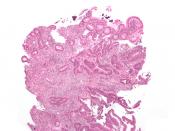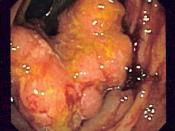Colorectal cancer is the presence of malignant tumours in the bowel wall of the colon, rectosigmoid junction and rectum of the human body. These cancerous tumours usually begin as benign polyps. Of the four types of cancer, colorectal cancer is most commonly carcinomatoid, meaning that malignant tumours grow out from the surface epithelial layer of the body. Cancer cells caused by this disease can break away from tumours and spread to adjacent tissues and other organs of the body, thereby causing additional damage. Once malignant tumours have invaded other bodily organs, the disease becomes very hard to treat and may result in death.
Because tumours have a tendency to bleed, a common symptom of colorectal cancer is the presence of blood in stools. Fresh, bright red blood is possible evidence of a growth in the rectum or lower end of the colon, whereas dried blood might indicate a tumour at the beginning of the colon.
Another possible indicator is narrow stools. Thin stools can sometimes indicate that waste has been squeezed past some sort of obstacle, such as a tumour, on its journey through the colon/lower intestine.
Other symptoms include general stomach discomfort, vomiting, diarrhoea and stomach cramps. Cancerous tumours may grow large enough to cause bowel obstruction, which may prevent the passage of solids, liquids and even gas. This can lead to discomfort and severe abdominal cramps, especially if a tumour blockage restricts blood flow to the colon. Painful cramping may also indicate that a tumour has perforated the bowel wall, which is an acute medical emergency. Less severe warning signs of colorectal cancer include constipation, gas and bloating, and a sense of fullness in the stomach. Also, it is possible for colorectal tumours to cause iron deficiency anaemia. This is due to the blood passed in stools from...


